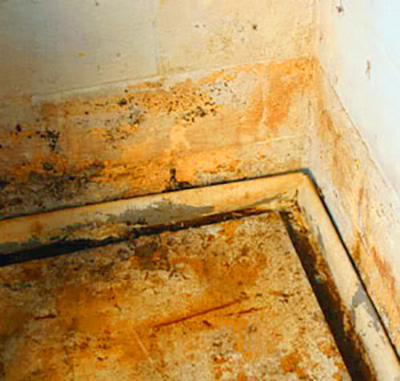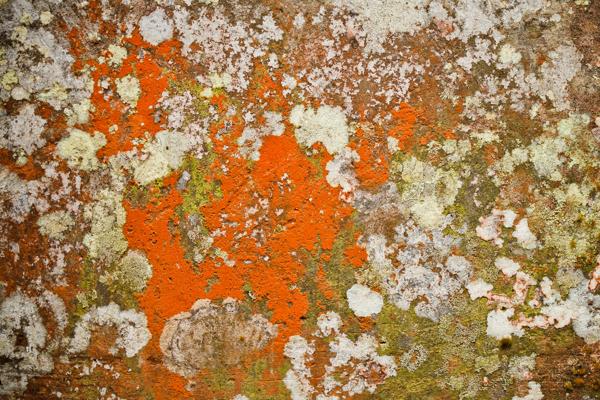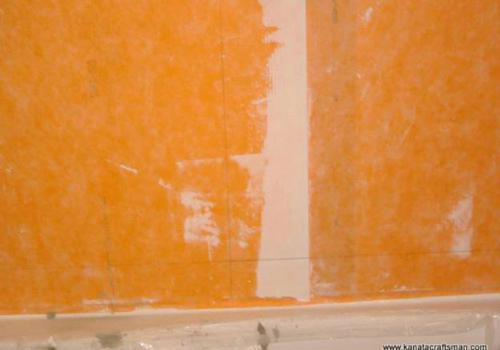| Topic | Key Points |
|---|---|
| What is Orange Mold? | Orange mold is a slime mold, not a fungus mold, and has a wet, slimy, and lumpy appearance. It can grow on almost any area of the home, but it favors damp and moist areas such as bathrooms, kitchens, certain walls, and hidden pockets of moisture within walls and crevices. |
| Identifying Orange Mold | Orange mold can be identified through its unique appearance and texture. It is moist, orange, and slimy, and when pressed, it is slightly springy. It may harden into a very dry rust that is hard to puncture after it has been touched. The inside of most orange mold species is black due to the presence of black spores. |
| Dangers of Orange Mold | Orange mold is not inherently dangerous on its own, but it can lead to negative or even life-threatening effects if left unchecked over time. The presence of orange mold in a home can cause people who have allergies, breathing problems, lung conditions, or weak immune systems to become ill. It can also lead to structural damage to the home if left untreated. |
| Removing Orange Mold | The methods for orange mold removal will vary depending on the location and size of the mold growth. For small areas of mold growth, a homemade solution of 1 part hydrogen peroxide and 3 parts water can be used. For larger areas, or if the mold growth doesn’t respond to treatment, it is best to call in a professional. |
| Prevention | The best way to prevent orange mold is to keep your home unattractive to mold species by avoiding moist environments, keeping surfaces clean and dry, inspecting your home for signs of moisture problems, and regularly checking food for mold growth. |
| Other Facts | Orange mold is the most common of all slime mold types, and there are several hundred known species of orange molds alone. Sometimes grows alongside other types of slime molds, including yellow and red varieties. |
No one wants to see orange mold growing in their home, whether it’s on their walls, inside their bathtub, or even on their food. There are actually many different kinds of mold, each of which has its own appearance, texture, and of course, color (see also: Pink Mold, Black Mold).
Orange mold is best known for its distinct color and unique appearance which is contrast to most common household molds.
If you believe you may have it mold in your home, you should take a closer look at this essential guide to help you understand how orange mold grows, why it grows, the potential dangers it poses, as well as what you can do to prevent and remove it.
What is Orange Mold?
Orange mold, like other molds, is a member of the Protista kingdom. Contrary to popular opinion, orange mold is not a fungus mold, although it has some similar properties. There are multiple species of orange mold, but what sets it apart from most types of fungus-based molds (such as red, black or green) is its distinct texture and appearance.
Unlike common household fungus molds which tend to have a “fuzzy” appearance, orange mold is a slime mold, which has a wet, slimy, and lumpy appearance. The most common type of orange mold is Fuligo septica, but the orange mold in your home may be a different specific type as well.

How to Identify Orange Mold
Orange mold can be identified through its unique appearance and texture. If you suspect you may have orange mold, take a stick and poke it into the mold growth. Orange mold, when pressed, will likely be moist and slightly spring. It may harden into a very dry rust that is hard to puncture after it has been touched.
If you want to be exactly sure of the type of mold you have growing, you could have a professional cut the dried mold with a sharp object to observe the inside; the inside of most orange mold species will be black due to the presence of black spores.
Never do this at home, however, due to the health risks in releasing black spores into the air. The best way to identify orange mold is through visual examination and touching with protective gloves.Most orange mold should be easy enough to identify due to its moist, orange appearance that many people find similar to vomit.
Where Does It Usually Grow?
Orange mold can grow in almost any area of the home, but it favors damp and moist areas such as bathrooms, kitchens, certain walls, and hidden pockets of moisture within walls and crevices.
They are also frequently grows on wood, especially wood that is kept outside as it tends to become moist. Orange mold may also be found on various foods, especially fruits and yogurt; moisture-heavy fruits such as oranges, lemons and limes are particularly prone to mold growth as well due to their water content.
Orange Mold in Shower & Bathroom
Orange mold is most often found in the bathrooms, especially orange mold in shower which is a humid area that is favored by molds due to the moisture and bacterial residue left behind after showering.
This mold is particularly common in bathrooms and showers in homes without a soft water filter, as the hard mineral content in hard winter is attractive to mold growth; in these cases, orange mold may also be found inside the bathroom sink drain.
Another common area for orange mold growth in the bathroom is the toilet bowl; especially in homes where toilets are not flushed immediately, as this allows for bacteria to grow inside the bowl. The more bacteria, the higher the chance for mold growth.

Orange Mold on Wood
Orange mold on wood is another common sight due to the presence of moisture in the wood—which is why it is particularly common on wood or wooden structures kept outside, although it can certainly grow on interior wood as well.
Orange mold tends to grow on wood that has been exposed to moisture, such as rainwater, or any types of bacteria that make it an ideal place for mold growth. A note: If there is significant orange mold on wood growth that is left untreated, this can cause the wood to weaken structurally over time, which could be dangerous for wood used in a structural capacity.
Orange Mold on Walls
Orange mold often grows on walls when there is an underlying moisture or water leakage problem in the home. Orange mold can grow on the exterior portion of the wall or in the interior portion, which makes it particularly difficult to spot until the growth is significant enough to smell or see.
If you live in an area with naturally high water acidity, you may find that the mold growth is more common than not, due to fact that rain water with high acidity is more prone to causing slime mold growth than other types of molds.

Orange Mold on Food
In general, food is an attractive location for mold growth, and orange mold is no exception. This mold is most common on moist foods such as bread, cheese, yogurt, dairy products, as well as fruits.
While mold on animal food should certainly be avoided.
If the food is stored in a moist environment, such as a warm bread box, then the likelihood for the mold growth will increase. It will also grow more often on foods that are rotting or otherwise past their expiration date, such as rotting fruit or old yogurt.
How to Get Rid of Orange Mold
The methods for orange mold removal will vary depending on the location of the mold and the size of the mold growth.
For orange mold in the bathroom, shower, or on walls, you should use a mold killing solution. You can find many mold killing liquid solutions inside the home goods and pest removal sections of retail stores.
If it’s a small area of mold growth, you can use a home-made solution by combining 1 part hydrogen peroxide and 3 parts water; then spray the mold with the solution and let it rest for 10 to 15 minutes.
Hydrogen peroxide is an anti-fungal, anti-viral and anti-bacterial solution that kills mold effectively on a variety of materials such as kitchen appliances, bathroom fixtures, floors and walls.
Put on gloves and scrub the location, repeating if necessary, until the mold is gone. If the area of mold growth is larger a few feet or doesn’t seem to be responding to your treatments, then it is time to call in a professional to handle the situation.
Professionals are especially important for interior mold growth due to the delicacy of removing mold on interior walls or wooden structures.

For this kind mold on wood, you can use commercial mold cleaners or the homemade mold killing solution. You must make sure that that the entire area of mold is removed as even small traces of mold will result in renewed and continued mold growth. Depending on the size and penetration level of the growth, you may need to throw out the wood or have it replaced if it is structurally important.
If you find this mold on food, throw the food away. Do not eat around the mold or pick off the moldy part and eat the rest of the food. You should also completely clean the refrigerator or food storage space where the moldy food was stored and dry it completely before putting mold-free food back inside. This will help reduce the chances of future mold growth.
Prevention
The best way to deal with orange mold (also another mold like Yellow Mold, Brown Mold, etc) is to prevent it from growing in the first place.
- Bathroom and shower: Thoroughly dry your shower every time you use it and make sure to clean it regularly to avoid the build-up of dirt and other bacteria. You should also never leave the bathroom floor or walls wet after showering or using the sink. Also make sure that you regularly flush your toilet, as this removes the bacteria-filled toilet water and replaces it with clean toilet water. You can help prevent orange mold in shower build-up further by installing a water softener if the water system in your home delivers hard water.
- Food: Keep food away from warm, humid locations such as certain types of bread boxes and containers. Always regularly go through your fridge and remove any high mold-risk food that is past its expiration date, such as yogurt and dairy. Inspect your food regularly to check for mold, especially if you have had an orange mold infestation before.
- Wood and walls: Keep your outdoor wood underneath a canopy to prevent rainwater from becoming absorbed into the wood; be sure to regularly inspect your wood for signs of this mold growth. For interior wooden structures, as well as walls, the best way to prevent orange mold is to look for signs of moisture problems or leaks within your home. Check for areas of the ceiling, wall or floor that may appear moisture-damaged, and always fix leaky faucets and pipes as soon as possible to prevent mold build-up.
Health Risks
Orange mold is not inherently dangerous on its own, but it can lead to negative or even life-threatening effects if left unchecked over time.
The presence of orange mold in a home can cause people who have allergies, breathing problems, lung conditions or weak immune systems to become ill. This may be potentially fatal depending on the severity of their health condition and the amount of mold spores in the air. Ingesting food with mold can have serious consequences for people with an unknown mold allergy or with a weakened immune system due to the presence of bacteria in the mold.
Orange mold on walls, inside walls and on wooden structures in the home will lead to damage to the wood’s natural structure. This could cause structural problems in the home that need to be fixed–which will be very expensive and could be potentially dangerous depending on what structure has been damaged.

Things to Know About Orange Mold
Here are some things to know about orange mold:
- Orange mold is the most common of all 700 to 900 slime mold types, and there are several hundred known species of orange molds alone.
- If orange mold dries out, it becomes extremely hard and difficult to break or cut without using sharp tools.
- Like other slime molds, it is often referred to as “vomit mold” by mold removers due to its distinct appearance.
- Commonly grows inside water filters, water pipes, and on the top of sink faucets; this will cause drinking water to take on a distinct unpleasant taste, which may be a first obvious sign of mold growth inside the home for homeowners.
- Should be removed ASAP if you live in a home with children, infants, pets, the elderly or anyone who has health problems related to breathing, the lungs or the immune system.
- The hazards presented by orange mold—like all molds—is not the exterior slime but the interior black spores. When these spores are released into the air, they can inhibit lung function, cause breathing problems, and other health issues for certain people.
- Sometimes grows alongside other types of slime molds, including yellow and red varieties.
Conclusion
Orange mold is a slime mold—not a fungus—that is common in areas of the home with high levels of moisture, including the bathroom, the shower, on walls, as well as certain types of food.
While it is not inherently dangerous to healthy adults, the presence of orange mold in the home can cause health complications for people with mold allergies, weak immune systems, and certain types of health conditions.
Orange mold (also another kind of mold like White Mold, Red Mold, Green Mold) and should be removed promptly, both to avoid any ill-effects on members of the household who are prone to mold sensitivity, as well as to ensure the mold is stopped before it grows too large.
Mold can be removed with mold cleaning solutions or by professional mold removal services, but the best way to deal with orange mold is to prevent it from occurring in the first place by ensuring your home is kept unattractive to orange mold species.